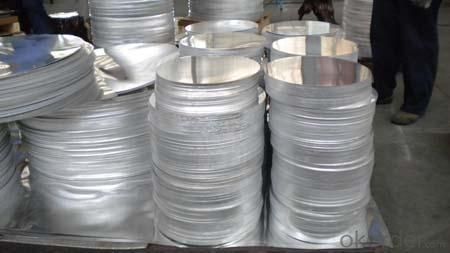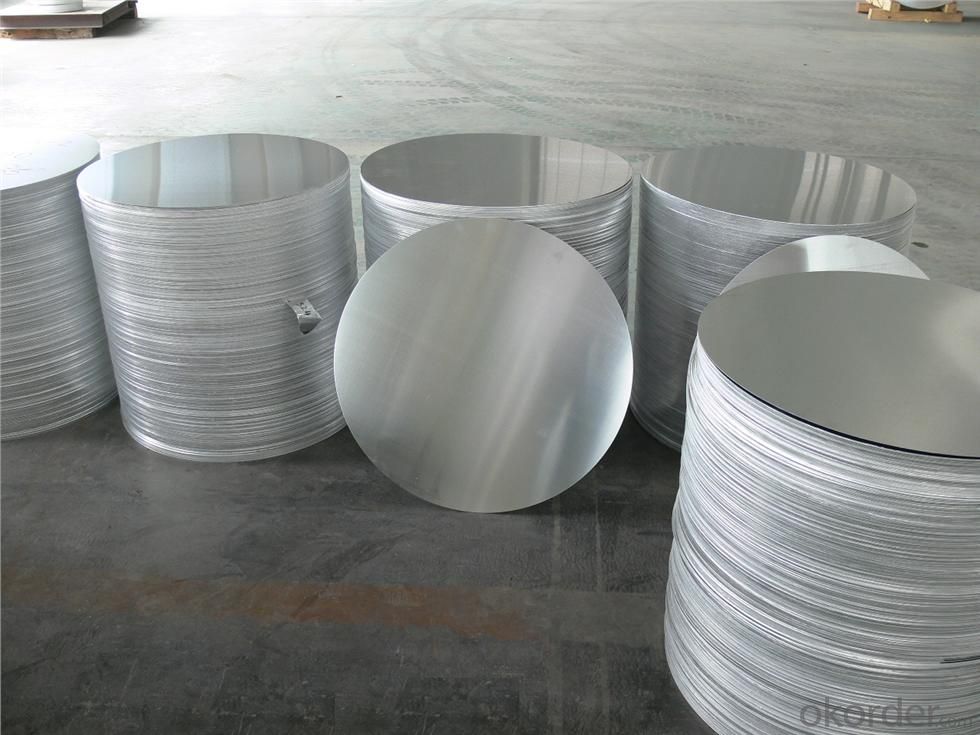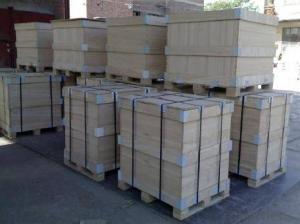Re-Roling Aluminium Circle for Deep Drawing
- Loading Port:
- Shanghai
- Payment Terms:
- TT OR LC
- Min Order Qty:
- 2 m.t.
- Supply Capability:
- 50000 m.t./month
OKorder Service Pledge
OKorder Financial Service
You Might Also Like
Item specifice
1.Structure of Re-Roling Aluminium Circle for Deep Drawing
Re-Roling Aluminium Circle for Deep Drawing is one semi-finished aluminium material. This strip can be rolled down to aluminium coil,sheet,circle ect. The alloy AA1050 is widly used in building, industry ect. Its weight is much lower than steel. So many customers choosed aluminium material instead of steel.
2. Main features of Re-Roling Aluminium Circle for Deep Drawing
a.Competitive price---We have our own mills and can produce mill finished aluminium coils, so we can control the production cost better.
b.Professional after-sale service---We have more than 15 years exportation experience and you need not worry about the exporation problems.
c.Fast delivery time---We can control the delivery time within 35 days.
3. Image



4. Product Specification
| Alloy | Temper | Thickness | Width | Weight |
| AA3003 | H14 | 0.2MM-3MM | 1000MM-1800MM | 2 TONS |
5.FAQ:
What is the quality standard?
---Usually our standard is GB3880-2006
What is the largest width?
---It is 2300mm
What is the MOQ?
---Usually we can accept 80 tons.
- Q:Can aluminum sheets be used for food display cases?
- Yes, aluminum sheets can be used for food display cases. Aluminum is a popular choice for food display cases due to its exceptional strength, durability, and resistance to corrosion. Additionally, aluminum is lightweight, making it easier to handle and transport the display cases. Its clean, sleek appearance also enhances the presentation of the food items, making it an ideal material for showcasing various food products. Moreover, aluminum is non-toxic and does not react with food, ensuring the safety and hygiene of the displayed items. Overall, aluminum sheets are a suitable and practical choice for constructing food display cases.
- Q:What are the physical properties of aluminum sheets?
- Aluminum sheets possess several physical properties, including being lightweight, corrosion-resistant, and having a high strength-to-weight ratio. They are also ductile, meaning they can be easily shaped or formed without breaking. Additionally, aluminum sheets have excellent thermal and electrical conductivity, making them suitable for various applications in industries such as construction, aerospace, and automotive.
- Q:I know 7005 series aluminum is stronger and lighter than 6061series, but how does 7005 compare to 2014 series?
- This okorder /.... Aluminum is a very different animal than steel, so the choice of alloy depends on what the application is. For instance, 7075-T6 is the most common high-end alloy for chainrings, but it has comparatively low tensile and yeild strengths.....and yet it's the most durable choice for the application. Chainrings made out of a stronger alloy won't last as long and may develop stress cracks. Some of the alloy choices depend upon machining and welding characteristics, too...it's not always about the strongest or lightest. You wouldn't want a part like a seatpost to be made of the material with the best numbers but that has a tendency to crack after welding.
- Q:What is the typical machinability of aluminum sheets?
- Aluminum sheets are widely acknowledged for their excellent machinability. This is due to their relatively low density and softness, which make them easier to machine compared to other metals. Furthermore, aluminum exhibits good thermal conductivity, enabling efficient heat removal during machining. Its low melting point also reduces the likelihood of overheating. Moreover, aluminum demonstrates favorable chip formation characteristics, resulting in effortless chip removal and decreased tool wear. However, the machinability of aluminum may differ depending on factors like alloy composition, tempering, and surface finish. Nevertheless, aluminum sheets are generally considered to be highly machinable.
- Q:Can aluminum sheets be used for insulation cladding?
- Yes, aluminum sheets can be used for insulation cladding. Aluminum is a lightweight and durable material that has excellent thermal conductivity properties. It can effectively reflect heat and prevent the transfer of thermal energy, making it an ideal choice for insulation cladding. Additionally, aluminum sheets are resistant to corrosion, moisture, and fire, further enhancing their suitability for insulation applications. Overall, using aluminum sheets for insulation cladding can help improve energy efficiency, reduce heat loss, and enhance the overall performance of a building or structure.
- Q:What are aluminum sheets used for?
- Due to their unique properties and versatility, aluminum sheets find a wide range of uses. In the construction industry, they are commonly employed for roofing, siding, and cladding, thanks to their lightweight nature, corrosion resistance, and durability. These qualities make them ideal for such purposes. In the transportation industry, aluminum sheets are widely utilized in the manufacturing of automobiles, trains, and aircraft due to their high strength-to-weight ratio. They also serve as a lightweight yet sturdy solution for trailers, truck bodies, and shipping containers. Another significant application of aluminum sheets lies in the manufacturing of consumer products. They are used to make household appliances, cookware, and electronics, as they possess excellent thermal conductivity and resistance to rust and corrosion. Additionally, their ability to withstand various weather conditions makes them suitable for the production of signage, billboards, and displays. In the packaging industry, aluminum sheets play a crucial role in the production of cans, foils, and lids. Their impermeability to light, moisture, and oxygen helps preserve the freshness and quality of food and beverages. Moreover, aluminum sheets have various industrial applications. They are utilized in the fabrication of industrial machinery, equipment, and tools due to their excellent machinability and strength. Additionally, their thermal and electrical conductivity makes them suitable for the production of heat exchangers, solar panels, and electrical conductors. In summary, aluminum sheets find application in construction, transportation, consumer products, packaging, and various industrial sectors, owing to their lightweight, corrosion resistance, durability, thermal conductivity, and electrical conductivity.
- Q:I'm working on this project and I have to glue together a 4mm thick aluminum and a 5mm aluminum. It's a 17mm wide hexagon.
- METHOD OF JOINING ALUMINUM TO ALUMINUM A welded joint having good electrical and mechanical characteristics is obtained between aluminum members by using a copper or copper alloy cloth or screen between the members to the joint. Heat and pressure are applied through resistance electrodes to melt the small wires of the screen and cause the aluminum metal to bond together.
- Q:who knows the ceiling technology of aluminum sheet?
- Construction technology of ceiling aluminum sheet: (1) firstly check keel’s quality, the straight shape and uniformly forced state of boom, control the keel’s gap within 500mm, reduce the gap according to design requirement under humid environment. The lower surface of keel is smooth without a sense of bearing down, main device is closely connected with accessories, it can be bound after being confirmed qualified.(2) we should break the board along the cutting line and ensure the margin of cutting board straight and square without any chipping or arris defect. (3) while placing and fixing the board, we can place edge of aluminum-plastic panel(encapsulated edge) in the vertical direction of supporting keel, there is a phenomena of hanging. Aluminum-plastic panel should be placed closely in the process of butt joint, it can’t be pressed. You can start from a plate angle or middle position, and don’t place them at the same time. Slab joint should be straight and in the same width, without break joint. (4) in the process of joint, Aluminum-plastic panel should be placed closely in the process of butt joint, it can’t be pressed. And the butt joint should be stagger, the butt joint can’t be connected on the same keel. When you use doubling plate, the joints of the second layer board and the first layer board can’t be connected with the same keel, double-deck gypsum board should be staggered joints.
- Q:Are aluminum sheets suitable for HVAC systems?
- Indeed, HVAC systems find aluminum sheets to be a fitting choice. As a lightweight and sturdy material, aluminum boasts exceptional thermal conductivity, rendering it highly suitable for integration into HVAC systems. It frequently serves as the base for crafting ductwork, heat exchangers, and fins within air conditioning units. Moreover, aluminum sheets exhibit corrosion resistance, which proves advantageous in settings with elevated humidity levels or instances of moisture exposure. Furthermore, aluminum stands as an eco-friendly alternative as it can be recycled, solidifying its status as an environmentally conscious option for HVAC systems. All in all, aluminum sheets present a multitude of advantages and remain widely embraced within the HVAC industry.
- Q:Are aluminum sheets suitable for high-pressure environments?
- In high-pressure environments, aluminum sheets are generally unsuitable due to their relatively low strength-to-weight ratio compared to other materials. Consequently, there is a potential for deformation or failure under high pressure, posing safety risks. Moreover, aluminum's structural integrity is further compromised in these situations due to its relatively low melting point. Therefore, materials like steel or titanium, which offer greater strength and resistance to deformation, are typically preferred in such environments.
1. Manufacturer Overview |
|
|---|---|
| Location | |
| Year Established | |
| Annual Output Value | |
| Main Markets | |
| Company Certifications | |
2. Manufacturer Certificates |
|
|---|---|
| a) Certification Name | |
| Range | |
| Reference | |
| Validity Period | |
3. Manufacturer Capability |
|
|---|---|
| a)Trade Capacity | |
| Nearest Port | |
| Export Percentage | |
| No.of Employees in Trade Department | |
| Language Spoken: | |
| b)Factory Information | |
| Factory Size: | |
| No. of Production Lines | |
| Contract Manufacturing | |
| Product Price Range | |
Send your message to us
Re-Roling Aluminium Circle for Deep Drawing
- Loading Port:
- Shanghai
- Payment Terms:
- TT OR LC
- Min Order Qty:
- 2 m.t.
- Supply Capability:
- 50000 m.t./month
OKorder Service Pledge
OKorder Financial Service
Similar products
New products
Hot products
Related keywords





























